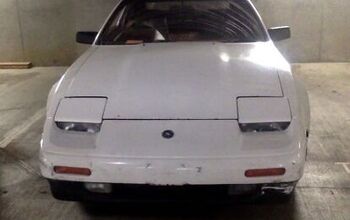Tesla Stock Gets Double Whammy From Analyst Downgrade and Model S Fire
The price of Tesla Motors stock took a double hit this week as an influential analyst downgraded the company’s investment potential almost simultaneously with the viral spread of a Model S electric car burning in Washington state after running over metal debris in the road. On Wednesday morning, the Robert W. Baird company changed its rating on shares of Tesla from “Outperform” to “Neutral”. Around the same time Wednesday, Jalopnik posted a cellphone video of the burning Model S. As the video spread throughout the online automotive community and Baird analyst Ben Kallo’s report spread through the financial community, Tesla stock prices declined all day on Wednesday, finally finishing down 12.05 at $180.95 on volume that was higher than average for the stock.
The Baird report said that Tesla stock had peaked in value and that changes in the investment structure of the EV startup made the stock less attractive to investors. Kallo’s report said, “Although we continue to be bullish on TSLA’s long-term prospects, we think the stock appreciation reflects its technological leadership and several milestones that could contain execution risk. We would look to become more constructive on execution related pullbacks or significant advances in battery technology.” With the stock’s 470% gains and the end of the year approaching, institutional investors may have taken the report as a signal to secure their gains and cash out. Another report on Tesla from Bank of America said that pension funds and other large investors were exiting Tesla. CNN reported that small investors were buying those shares, a move seen by analysts as negative.
Regardless of the stock fluctuations and a drop in market value of approximately $3 billion analysts say that Tesla should still have no problems securing financing for current operations and for the development of the Model X crossover and the mass market EV that Tesla CEO Elon Musk has promised. Still, as a maker of only electric powered cars, Tesla is far more exposed in the event of problems with EVs than those established car companies that are exploring electrically powered cars and trucks.
Tesla cars have been driven for a combined 113 million miles, according to the company, and the Washington state fire was the first case of a Tesla battery pack burning, which puts the rate of burning Teslas at 1/10th the rate of fires in conventional gasoline or diesel powered cars. Despite the fact that hundreds of thousands of cars and trucks catch fire one way or another every year in the U.S. with little attention, isolated fires involving cars such as the Chevy Volt, Fisker Karma, and Mitsubishi’s i-MiEV and the lithium ion batteries used in the new Boeing Dreamliner have drawn considerable interest and possibly created a marketing obstacle for electric cars. Those few EV fires followed recalls by Apple for far more numerous fires involving the lithium ion batteries used in laptop computers. Though the most successful of the EVs and hybrids, the Toyota Prius, uses nickel-metal hydride battery cells, the automobile industry has been moving to lithium-ion, as used in the Chevy Volt, Nissan Leaf and Ford C-Max. Li-ion batteries have better energy density and discharge characteristics. The are also lighter than NiMH batteries
After releasing his valuation report and the video of the fire going viral, Ben Kallo considered the impact of the fire. “Tesla’s a very controversial stock and this will give fodder for the bears. They’ll say this is going to slow down sales.” While short term the fire may hurt Model S sales, Kallo and other analysts still expect that Tesla will see strong demand going forward.
On their part, Tesla officials said that the battery and the car worked as designed, keeping the fire under control and allowing the driver time to pull over and safely exit the vehicle. “The fire was caused by the direct impact of a large metallic object to one of the 16 modules within the Model S battery pack,” Tesla spokeswoman Elizabeth Jarvis-Shean said. “Because each module within the battery pack is, by design, isolated by fire barriers to limit any potential damage, the fire in the battery pack was contained to a small section in the front of the vehicle,” she added. Panasonic Corp., which makes the Model S’ batteries, declined to comment.
While Tesla insisted that the burning Model S worked as designed, Clarence Ditlow, director of the Center for Auto Safety, said that there has to be a “design issue” with the Model S if an object striking the bottom of the car could lead to a battery fire.
Tesla’s battery pack uses standard form factor lithium-ion battery cells similar to those used in laptop computers. As a result, the combined battery pack takes up most of the underside of the Model S. By comparison, EVs from established car companies use custom sized battery cells so the finished battery packs can be packaged more compactly as in the T-shaped battery pack located in the middle of the Chevy Volt.
More by TTAC Staff
Latest Car Reviews
Read moreLatest Product Reviews
Read moreRecent Comments
- Analoggrotto I hope the walls of Mary Barra's office are covered in crushed velvet.
- Mikey For 36.4 years i punched the clock at GM Canada.. For the last 15.5 years (frozen at 2008 rates) my GM pension shows up in my account. I flirted with Fords for a couple of years but these days I'm back to GM vehicles and still qualify for employee price. Speaking as a High School drop out ..GM provided myself and family a middle class lifestyle.. And still does .. Sorry if i don't join in to the ever present TTAC ..GM Bash fest
- Akear Does anyone care how the world's sixth largest carmaker conducts business. Just a quarter century ago GM was the world's top carmaker. [list=1][*]Toyota Group: Sold 10.8 million vehicles, with a growth rate of 4.6%.[/*][*]Volkswagen Group: Achieved 8.8 million sales, growing sharply in America (+16.6%) and Europe (+20.3%).[/*][*]Hyundai-Kia: Reported 7.1 million sales, with surges in America (+7.9%) and Asia (+6.3%).[/*][*]Renault Nissan Alliance: Accumulated 6.9 million sales, balancing struggles in Asia and Africa with growth in the Americas and Europe.[/*][*]Stellantis: Maintained the fifth position with 6.5 million sales, despite substantial losses in Asia.[/*][*]General Motors, Honda Motor, and Ford followed closely with 6.2 million, 4.1 million, and 3.9 million sales, respectively.[/*][/list=1]
- THX1136 A Mr. J. Sangburg, professional manicurist, rust repairer and 3 times survivor is hoping to get in on the bottom level of this magnificent property. He has designs to open a tea shop and used auto parts store in the facility as soon as there is affordable space available. He has stated, for the record, "You ain't seen anything yet and you probably won't." Always one for understatement, Mr. Sangburg hasn't been forthcoming with any more information at this time. You can follow the any further developments @GotItFiguredOut.net.
- TheEndlessEnigma And yet government continues to grow....

































Comments
Join the conversation
At least the batteries are designed to burst into flames in front of the driver and not under the seat bottom as to warn the driver of impending failure and pull over.
Anything that wipes the smirk off that Musk guy's face is OK by me.